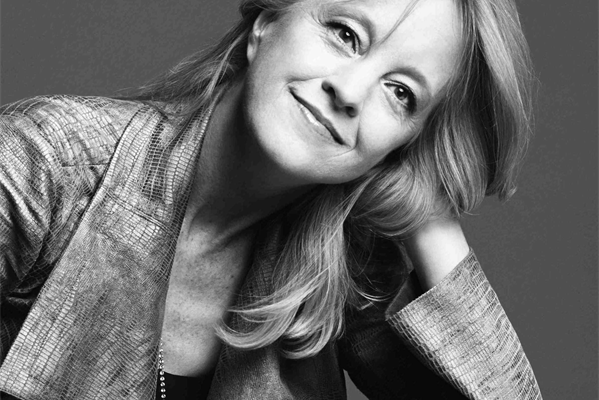There are eighteen people arrayed upon the stage. The stage is small, so a whole row of these eighteen, six of the most important members of this flock, spill onto the floor of the Jazz Standard. The accordion player is even forced to sit in a booth with his music stand before him. The walls of the stage are bright red cushioning, like the breast of a goshawk about to fly.
It is the first performance of the 13th annual Thanksgiving residence of the Maria Schneider Orchestra, and there, seated amidst the crowd so large is her orchestra, stands Schneider herself. And she is in control.
Schneider played no instrument at the 7:30 set on the 21st, but she played the orchestra as a virtuoso. Her hands were a thing of beauty. Her fingers were red like farmer’s fingers in the cold and they had the veins of a laborer, but they were so supple in their movements. They kept time with swooping movements yet pulled out solos and jabs of brass with a grasp of a fist. The smallest gesture was acknowledged immediately. She would flick one finger at a saxophonist who appeared to be completely focused upon his sheet music and that saxophonist would hit the change with seemingly no delay. It did not even seem like the thought had to be processed in his brain. The command went from her fingers to his.
That is not to say the orchestra and the members in it had no individuality. One of Schneider’s great skills is casting, and the soloists she chooses for her pieces are perfectly cast to highlight the emotional core of each piece. Dave Pietro’s solo on “All Night, in Gusty Winds,” a song about marital love and saving powers of love, brought tears to my eyes. But these solos, so impressive in themselves, and which I will dive into in more detail later, are Schneider’s tools to tell you the story she wants you to hear.
Schneider has mastered flight. Each song pulsed and receded on swirls of trumpets and saxophones like thermal winds and summer breezes while the excellent piano, bass, and drum trio of Frank Kimbrough, Jay Anderson, and Clarence Penn held down the center, riffing and moving with the changes in ways that both were alive with improvisation and kept the beat so well they could have been playing Bach. But from this deeply consistent and harmonic whirlwind always rises the solo like a high-flying bird. Many of Schneider’s songs reference the wind, but it was not until I heard Greg Gisbert’s floating, dropping, rising solo on “Hang Gliding” that I understood just how central the theme of flight is to Schneider (I admit a degree of idiocy here, since she has an entire album called Sky Blue). Until that moment, I had been looking at the orchestra as a battle formation—a roman legion led by Caesar himself—but after that solo, I understood: They were the flock and Schneider the falconer.
The songs swirled and swirled around the pulse of the chords and then Schneider would signal to the soloist and they would ascend, released form the master’s hand. It is almost impossible to overstate how much trust there must be between as exacting a composer as Schneider and her musicians to allow such freedom. Schneider, during the solos, would sit down, would seem to leave the stage, yet was still entirely conducting, counting the changes, deciding when and how to bring the aerie back, yet she would never cut off a soloist, and the soloists never let her down.
The aforementioned “Hang Gliding” was a peak of the night for me, a very well chosen set closer. It was introduced by Schneider as being inspired by her experience of hang gliding in Brazil. “An experience that was more fun in retrospect,” she said. She told the audience that she had floated up high on a thermal and then dropped with great speed, slicing along the cliff faces at top speed, and that those two experiences would be recreated by Greg Gisbert and Donny McCaslin respectively. I have already said that Gisbert played his part well, but I want to highlight again how his solo could change from long tonal notes to quick drops of modal bopping then rose so high that his trumpet could almost not be heard (a common end to the night’s solos). And Gisbert was given almost complete silence surrounding his solo, and, judging by their smiling faces, his bandmates approved. McCaslin’s solo was, appropriately, completely different, fully surrounded by the orchestra for its duration, existing as a bright, hot thread amongst the twisting chords. Or imagine a red-tailed hawk darting among the sharp beaks of swallows. McCaslin could not be contained, he flew free, but he was also kept in line by those hands that were off the stage.
I also want to highlight the very great solo work of Mike Rodriguez and Scott Robinson on “Gumbo Blue.” The song was meant to be a showcase for great soloists, and it was, but there was an interesting dynamic to the solos. First came trombonist Marshall Gilkes who gave a solo that stayed in the middle. There were no great heights nor deep lows, but instead a sequence of deeply skilled phrasings that did not grab me. Though I am deeply unclassy. I ordered a Cheer Wine soda at the Jazz Standard, where they sell fine bourbon, so take my words for what you will—His fellow bandmates seemed very impressed with Gilkes’ work. But after Gilkes came Rodriguez.
Where Gilkes kept to the middle tones and had grey hair and glasses, Rodriguez blew out his trumpet and sported a slick black ponytail and an earring. It felt like there was a direct challenge in the very fast, very, very high notes that Rodriguez focused on. In fact, his solo ended with tones too high for him to correctly play on his trumpet. They came out as whistles or tweets more than notes. This did not bother me, but I did wonder if the younger bird had flown perhaps too high in direct challenge to the steady starter.
My favorite solo of the night, however, was the last in “Gumbo Blue,” Scott Robinson’s saxophone solo. Robinson’s work combined the sensibilities of the first two soloists: Gilkes’ low and middle tones first followed by the high and fast virtuosity of Rodriguez. It was moving, skillful, and a delight to hear. Now, I have no doubt that the tensions here described are inherent to the piece, its beating heart, and that any animosity was merely imagined, but the skill of these players and the skill of Schneider’s casting them in opposition created the arc of the piece.
The Orchestra also performed the New York debut of a piece called “Don’t be Evil,” whose title is drawn from Google’s motto. Schneider has, shall we say, less than positive feelings about Google. She recently wrote an article entitled “Like a Wood Chipper on Steroids” about YouTube’s unfair treatment of copyright holders, and she feels that Google, as the owners of YouTube, are not living up to their motto’s promise given their treatment of copyright and metadata. “Don’t be Evil,” was an interesting inversion of Schneider’s normal mode. There was still the swell and recede of the brass, all tonal harmony, but instead of the soloists rising high on the thermals of these warm changes, they, particularly guitarist Ben Monder, dug into the dirt. Monder used flange as though he were Slash and shredded in a minor modulation of the home key, sounding for all the world like a collection of grubs thrashing in the mud. It was fun to watch the flock of gleaming birds perform a Danse Macabre.
But in the subterranean aviary of the Standard, all of us in the warm dark facing this intimidating wall of talent, something nagged at me.
Schneider works in the place where classical music and jazz unite. It is hard to define Jazz and Classical music, but I would say that part of their definition must center on class. Yes, Liszt and Mozart and Schubert and Bach were all the rock stars of their day complete with drug abuse and wild sex lives, but they also mingled with, and were supported by, the wealthy nobility of Enlightenment and Absolutist Europe. Classical music gorgeous clockwork could not exist without the patronage of royalty.
Jazz, on the other hand, arose from experience of Black Americans. Jazz has its roots in the blues and African rhythms and sounds. It arose in opposition to the culture of the wealthy. Jazz’s founders and most of its great practitioners were reacting to the struggle of their lives, swinging the beat like a taffy pull and soaring above the chords to make something different and seemingly uncontrolled, certainly improvised. And for the most part what patronage Jazz had was the common record buyer. Louis Armstrong lived off records as much as performances, certainly Miles Davis did and Ella. Jazz was built on the ability of common people to support artists through copyright, even if through the cruel intermediary of a record company.
Schneider, however, is existing in the place between. Her music is definitively improvisational, but it has the deep structure of a classical piece, and her business model, too, is somewhere in between. Schneider only sells her records through artistShare, a co-op record company. That means that Schneider sells her albums directly to you. There are not even in stores. And that grants her great commercial freedom—she records the music she likes. But not quite. Schneider writes on commission, and those commissions are costly. She, like the classical musicians did, works on a patronage system—even as she also lives through the copyright system that sustained jazz (and rock) at its height. So her attack on YouTube and on Google, “Don’t be Evil’s” kicking back at the digital revolution, is even more interesting. Schneider is trying to hold back the rising tide of free copies, of the “desire of information to be free.” She is holding her ground for a system that is dying, and to make up for copyright’s losses, she works for patronage. That alone shows the power of a strong copyright and strong material art culture to democratize an art form. We can support artists by buying their art.
But arguing for material artistry it is also an argument against democratization, an argument for enshrining gatekeepers who make the copies. The digital revolution allows people who could not afford even one of Schneider’s CDs to listen to her music. And it allows people, like me, to look her up and, if she streamed, to listen to her the moment I heard of her. From intrigued stranger to fan in no time flat. Yet Schneider is also correct that streaming sucks for artists, as does YouTube. There is no easy answer. But maybe artistShare could pick up all the slack if everyone did it. Maybe.
So those eighteen are arranged before that holy red backdrop, and I, through wonderful economic luck, can sit and enjoy some of the most beautiful and transcendent music I believe I will ever hear. I can see past this dark culture cave to the pure forms of these falcons swooping as Schneider looses and recalls them. But I am struck by how many could not, and what that says about the absolute beauty of Schneider’s work.
The falcon, after all, was the bird of the king alone.




